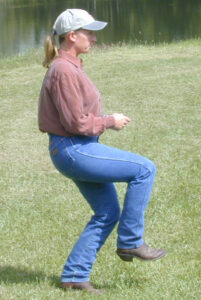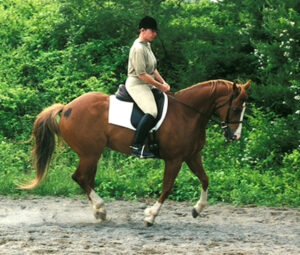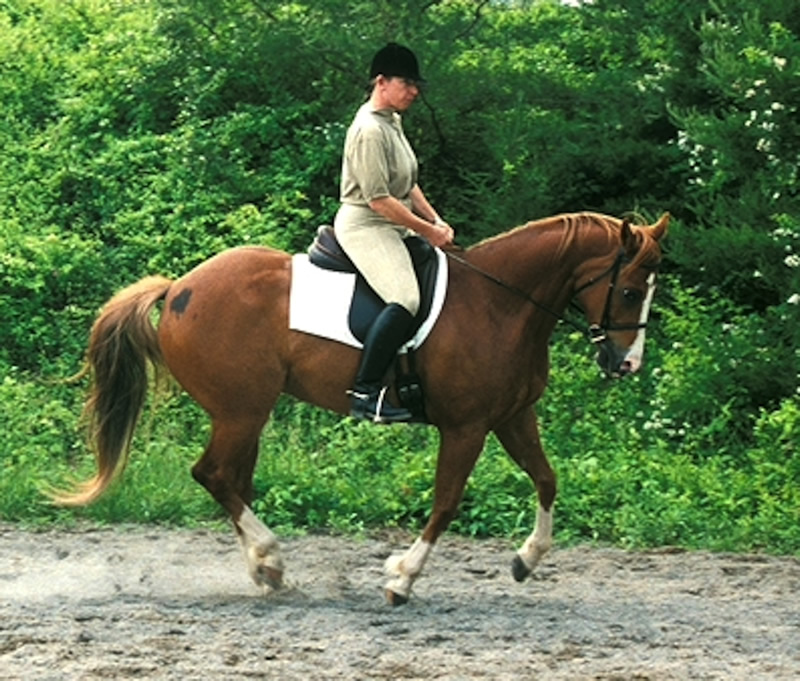Do you have trouble cantering? Does your horse rush, resist or have difficulty maintaining canter? Are you better on one lead vs. the other? Do you have problems with your transition into or out of canter? Cantering on your own two feet on the ground can be revealing and can dramatically improve your canter on the horse.

Next time you ride notice what happens when you canter. Does your horse run into it? Does he fall on the forehand? Do you stiffen especially in transitions? Do you hold your breath when simply thinking about cantering?
Some horses do have difficulty with canter. To diagnose the problem go through the following checklist. Can your horse canter on both leads:
• In the field?
• When you free lunge him?
• On the lunge without tack?
• With tack?
• Easily with someone else riding him?
If one or more of these answers is “no” then your horse needs some help in order to improve his ability to canter with a rider. Depending on how far you got in this checklist you may need to consult a veterinarian, physical therapist or a good trainer for your horse. If the answer to all of these questions is “yes” you need to do some cantering on the ground to improve yourself.
When I ask riders to canter on the ground some students cannot canter at all! Others demonstrate the exact same problems they have under saddle. Working it out off the horse takes the rider’s anxiety away and is less stressful on the horse.

Go for a canter on your own two feet. What you do? Have someone watch you to point out what they see. What lead did you unconsciously choose? Is this the same lead that your horse prefers? How awkward is the other lead? How difficult is it to change leads? Where are you tight or stiff? Hips, knees, ankles, lower back, etc.? Does your “hind leg” feel weak on your “bad” lead? Do you canter on the forehand? Do you twist your torso when you canter so that your pelvis is aimed to away from the direction of travel?
Notice the quality of your canter and your length of stride. Do you have any suspension or is it flat? The canter is a three-beat gait and you only have two legs, however is there a distinct pattern of movement (hind leg, lead leg, suspension) to cantering on the ground. Is it the same on each lead? If you were to collect your canter do you lose all rhythm and suspension?
Place both hands on the thigh of the leading leg. Bend the joints of the supporting leg. Tap your lead foot a few times using your hands to spring your leg off the ground without losing your balance. Canter off continuing to spring the lead leg off the ground with your hands.
With your hands on your lead leg your body is much straighter and the motion of canter is absorbed in you legs rather than in your lower back. Feel how the hip joints need to open and close (thigh moving up towards and away from your torso) with each stride. Remove your hands from your thigh and pretend to hold the reins. See if you can maintain the same amount of suspension, rhythm and balance as you canter circles, turns and transitions from trot to canter.

Use this Murdoch Minute to sort out your canter problems. When you get back on your horse remember the feeling you had while cantering on the ground. Allow your the legs absorb the motion while your upper body remains quiet. Let the horse do the cantering while you go with the motion. Remember to keep the motion and rhythm of the canter going in your legs while the upper body remains balanced above. And always remember to enjoy the ride!
Wendy Murdoch is available for lessons and clinics in the Northern Virginia region as well as throughout the United States. She teaches riders of all levels and disciplines how to improve the horse’s performance by improving their body position. On-line join Wendy’s Facebook group Fans of the Murdoch Method and find more articles, blog and her new book 50 5-Minute Fixes to Improve Your Riding, based on the Murdoch Minutes at www.murdochmethod.com




